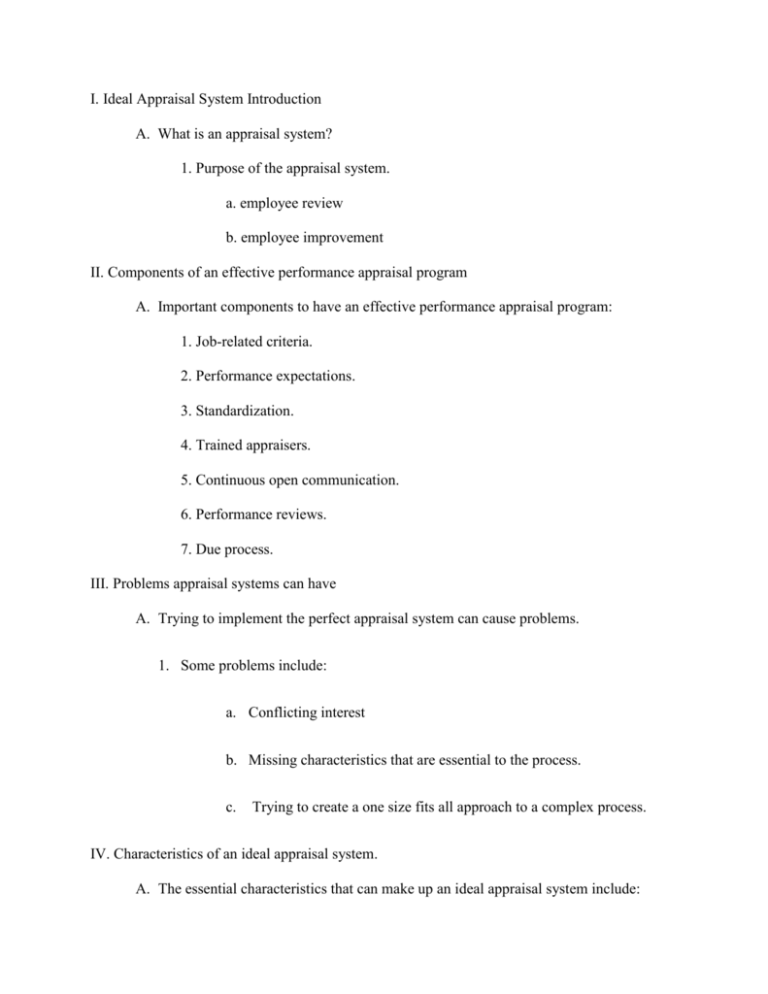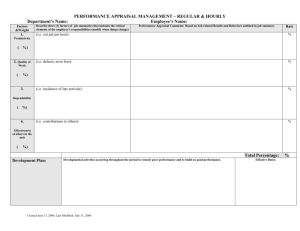
I. Ideal Appraisal System Introduction
A. What is an appraisal system?
1. Purpose of the appraisal system.
a. employee review
b. employee improvement
II. Components of an effective performance appraisal program
A. Important components to have an effective performance appraisal program:
1. Job-related criteria.
2. Performance expectations.
3. Standardization.
4. Trained appraisers.
5. Continuous open communication.
6. Performance reviews.
7. Due process.
III. Problems appraisal systems can have
A. Trying to implement the perfect appraisal system can cause problems.
1. Some problems include:
a. Conflicting interest
b. Missing characteristics that are essential to the process.
c.
Trying to create a one size fits all approach to a complex process.
IV. Characteristics of an ideal appraisal system.
A. The essential characteristics that can make up an ideal appraisal system include:
1. Valid data
2. Reliable
3. Responsive
4. Flexible
5. Equitable
V. Ideal Appraisal System Conclusion
A. Overview of the Ideal Appraisal System
1. Effective performance appraisal program.
2. Problems with performance appraisal programs.
3. Characteristics of an ideal performance appraisal program
Abstract
Companies use a performance appraisal program to help improve their employee base by either
evaluating each employee to find their strengths that can be passed on to other employees and
weaknesses that would need to be improved upon for the employee to do better. Employees that
are able to improve their performance will contribute more to a company running as smoothly as
possible. The performance appraisal program will be more effective if the program is designed
around the job criteria, performance expectations, trained appraisers, continuous communication,
and other elements. Problems can occur if a performance appraisal program is not implemented
correctly or is missing elements, such as trying to adapt a program from another company that
may not be a perfect fit even if it is successful elsewhere. An ideal appraisal system will be able
to overcome the different potential problems to create a perfect system that will have useful
results for the company and their employees.
Keywords: employee appraisal program, performance appraisal program
According to Grote (2003), “Performance appraisal is a formal management system that
provides for the evaluation of the quality of an individual’s performance in an organization” (p.
1). The purpose behind a performance appraisal program may seem simple enough in that it is
trying to identify the strengths and weaknesses of a particular employee to verify if the employee
is working up to the level that they should be along with whether or not an employee deserves to
be given a raise. A performance appraisal program has a bigger purpose for the company than
just determining if an employee deserves a merit raise or is doing an excellent job. It can help to
keep a company running more smoothly by identifying what is going well with employees, and
what can need to be improved upon by that employee to better the organization. Employee
improvement is vital as every employee probably has one area that they can improve upon or
skill that can be offered to others.
Understanding the purpose of having a performance appraisal program in place at a
company can help to determine which components are necessary to create an effective
performance appraisal program. According to Kleynhans et al. (2009), “Features of an effective
appraisal system include using job-related criteria, performance expectations, standardisation,
trained appraisers, continuous open communication, performance reviews and due process” (p.
170). One of the first portions of an effective performance appraisal program is that the system
employs the use of job-related criteria that must be met by each position. Using a cookie cutter
system that puts every position at a company evaluated with the same criteria is doing a
disservice to those individuals that have very complex or very simple jobs within a company.
The tasks performed by a mailroom clerk and the head sales person will be vastly different, and
the criteria used to evaluate their performance should reflect those differences. Setting
performance expectations for an employee when they are hired or promoted into a position lets
that employee know exactly what is expected of them by the company and helps to prevent
miscommunication during the performance appraisal process. An employee not knowing what is
expected of them in their job performance could not really be criticized when they are not
reaching their performance expectations.
Although there needs to be differences in the performance appraisal program to account
for different job duties, there is a need for standardization to help keep the process fair for all
employees. Employees that witness that they are the only ones going through the performance
appraisal program may feel as though they have been singled out for a reason, and can result in
employee dissatisfaction. It is also important to have trained appraisers that are familiar with the
performance appraisal process as they can help to garner better results with the use of someone
that understands how best to go over an appraisal with an employee. They are able to inform the
employee without making them feel overly upset or too criticized. Continuous open
communication is also vital for a performance appraisal program to be successful as employees
will feel very resentful if they believe that they have been fulfilling their job performance
expectations during the year and find that the appraisal states something completely different.
Due process is important to allow for employees to have a say in their performance appraisal as
they may not agree with what has been written, and can provide evidence to support their
opinion.
There can be potential problems with putting an appraisal system into place. According
to Edwards, Scott and Raju (2003):
It is tempting to think that the ‘ideal’ performance appraisal system is one that addresses
as many of these goals as possible. However, in practice the attempt to get as much
‘bang for the buck’ can backfire because there is no single ‘most effective’ approach to
measuring performance. (p. 157)
First, there can be a conflicting interest for managers that want to instill an amount of fear in
their employees because they have control of their appraisals to try to get the best performance
out of their employees to make themselves look good as a manager. There is also the fact that
there can be missing characteristics, such as not allowing for due process or having continuous
communication. There can also be the fact that the company may try to use a one size all
approach to a very complex process. A company may try to adapt a successful performance
appraisal program from another company, but may find that it is not as successful for their
company as it was for the one that they adapted it from because their company has differences
from the other.
There are some characteristics that a company can put into place to create an ideal
appraisal system for their workplace. According to Nelson and Quick (2012), “An effective
performance appraisal system has five key characteristics: validity, reliability, responsiveness,
flexibility, and equitability” (p. 215). Validity refers to the appraisal system requiring a
complete view of the different criteria that makes up an employee’s tasks as some employees in a
position may have more tasks to complete than other employees in similar positions. These
additional tasks may be because of a particular skill of an employee or an employee being
groomed to be promoted to a supervisory position or other position that requires them to have
additional training. Reliability means that the data is accurate, and brought in from more than
one source at different periods of time. This will help to account for periods of time when an
employee may be unable to effectively perform their duties, such as a death in the family or
illness, and will not allow an appraisal to focus only on that short period of time. This can also
help to eliminate any bias that a manager or supervisor may have towards an employee by taking
in other sources, such as peer reviews.
Responsiveness makes the performance appraisal system more of a two way street that
allows for employees to be able to have their own input into the process. Flexibility allows for
changes to be made if the company deems that something is missing to help improve the system
or if the government releases new guidelines that need to be taken into account for how
employers treat their staff. Equitability is that the ideal performance appraisal system will allow
for every employee to be treated fairly under the new system.
In conclusion, a performance appraisal program is a process that a company can adapt to
help learn about the strengths and weaknesses of their employees to determine how best to
improve their performance and how to maybe improve the performance of other employees
utilizing the exceptional skills of other employees. This can be seen as a negative process by
supervisors that feel that they are wasting their time to employees worrying if they will get a
raise for the following year, but can be very positive. “Because one of the major purposes of the
appraisal interview is to improve an employee’s future performance, his or her manager should
focus the person’s attention on the future rather than the past…” (Snell & Bohlander, 2011, p.
378). The performance appraisal program can be made effective if the company installs the
different components that are essential to a successful program. Each of these components can
work well together to make a program that will work well for the company. A program that is
not set up correctly can cause there to be problems in the performance appraisal process that
would need to be fixed to obtain an ideal performance appraisal program. To install an ideal
performance appraisal program, it is vital to have the following characteristics implemented into
the program, such as reliability, responsiveness, equitability, validity, and flexibility.
References
Edwards, J. E., Scott, J. C., & Raju, N. S. (2003). The Human resources program-evaluation
handbook. Thousand Oaks, Calif.: Sage Publications,.
Grote, R. C. (2003). The performance appraisal question and answer book a survival guide for
managers. New York: American Management Association.
Kleynhans, R., Markham, L., Meyer, W., O'Neill, C., Schlecter, A., Aswegen, S. V., et al.
(2009). Human resource management: fresh perspectives. Cape Town: Pearson/Prentice
Hall South Africa.
Nelson, D. L., & Quick, J. C. (2012). Organizational behavior: science, the real world, and you
(8th ed.). Mason, Ohio: South-Western.
Snell, S., & Bohlander, G. W. (2011). Managing human resources (16th ed.). Mason, Ohio:
South-Western.







